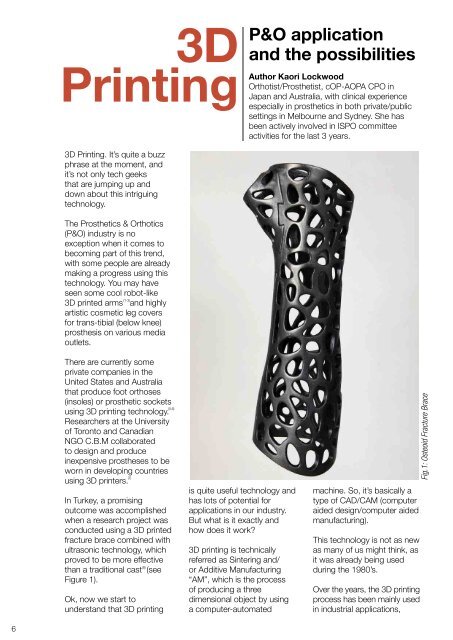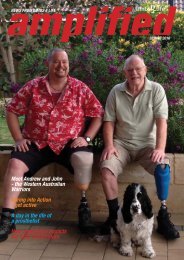Prosthetic Technology
L4L Amplified Summer_online
L4L Amplified Summer_online
Create successful ePaper yourself
Turn your PDF publications into a flip-book with our unique Google optimized e-Paper software.
Printing<br />
Author<br />
3D Printing. It’s quite a buzz<br />
phrase at the moment, and<br />
it’s not only tech geeks<br />
that are jumping up and<br />
down about this intriguing<br />
technology.<br />
The <strong>Prosthetic</strong>s & Orthotics<br />
(P&O) industry is no<br />
exception when it comes to<br />
becoming part of this trend,<br />
with some people are already<br />
making a progress using this<br />
technology. You may have<br />
seen some cool robot-like<br />
(1-3)<br />
3D printed arms and highly<br />
artistic cosmetic leg covers<br />
for trans-tibial (below knee)<br />
prosthesis on various media<br />
outlets.<br />
3D<br />
P&O application<br />
and the possibilities<br />
Kaori Lockwood<br />
Orthotist/Prosthetist, cOP-AOPA CPO in<br />
Japan and Australia, with clinical experience<br />
especially in prosthetics in both private/public<br />
settings in Melbourne and Sydney. She has<br />
been actively involved in ISPO committee<br />
activities for the last 3 years.<br />
There are currently some<br />
private companies in the<br />
United States and Australia<br />
that produce foot orthoses<br />
(insoles) or prosthetic sockets<br />
using 3D printing technology.<br />
Researchers at the University<br />
of Toronto and Canadian<br />
NGO C.B.M collaborated<br />
to design and produce<br />
inexpensive prostheses to be<br />
worn in developing countries<br />
(7)<br />
using 3D printers.<br />
In Turkey, a promising<br />
outcome was accomplished<br />
when a research project was<br />
conducted using a 3D printed<br />
fracture brace combined with<br />
ultrasonic technology, which<br />
proved to be more effective<br />
(8)<br />
than a traditional cast (see<br />
Figure 1).<br />
Ok, now we start to<br />
understand that 3D printing<br />
(5,6)<br />
is quite useful technology and<br />
has lots of potential for<br />
applications in our industry.<br />
But what is it exactly and<br />
how does it work?<br />
3D printing is technically<br />
referred as Sintering and/<br />
or Additive Manufacturing<br />
“AM”, which is the process<br />
of producing a three<br />
dimensional object by using<br />
a computer-automated<br />
machine. So, it’s basically a<br />
type of CAD/CAM (computer<br />
aided design/computer aided<br />
manufacturing).<br />
This technology is not as new<br />
as many of us might think, as<br />
it was already being used<br />
during the 1980’s.<br />
Over the years, the 3D printing<br />
process has been mainly used<br />
in industrial applications,<br />
Fig.1: Osteoid Fracture Brace<br />
6




